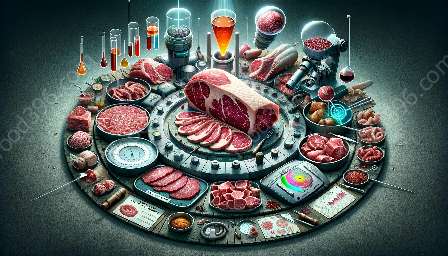Meat, as a staple food in many cultures, is consumed and enjoyed worldwide. The quality of meat is a critical factor in determining its desirability and value. Evaluating marbling and fat distribution in meat is an essential aspect of ensuring meat quality. This topic cluster delves into the significance of marbling and fat distribution, their impact on meat quality, and the factors influencing these characteristics, all within the context of meat science.
Meat Quality Evaluation
The evaluation of marbling and fat distribution is a fundamental component of meat quality assessment. Marbling, also known as intramuscular fat, refers to the fine white streaks of fat that are dispersed within the muscle tissue of beef, lamb, and pork. The presence of marbling greatly influences the tenderness, juiciness, and flavor of the meat. It is commonly evaluated in the form of marbling scores, which provide a standardized measure of the fat distribution within the meat.
Fat distribution, on the other hand, encompasses the overall arrangement and dispersion of fat throughout the meat cuts. In addition to marbling, the external fat layers and fat caps on meats such as beef and pork are also evaluated for their distribution and thickness. This comprehensive assessment of fat distribution plays a crucial role in determining the overall quality and marketability of the meat.
Factors Influencing Marbling and Fat Distribution
Several factors affect marbling and fat distribution in meat. Genetics, breed, age, diet, and management practices are influential in determining the degree of marbling and fat distribution within meat cuts. For instance, certain cattle breeds, such as Japanese Wagyu, are renowned for their exceptional marbling due to specific genetic traits. Additionally, the animal's age and diet play significant roles in the development of intramuscular fat and the overall distribution of fat within the meat.
Furthermore, the post-mortem handling of the carcass can affect the distribution of external fat and marbling. Proper chilling and aging processes are critical in preserving the quality of marbling and fat distribution, preventing deterioration and ensuring the desired characteristics persist throughout the meat cuts.
Significance in Various Meat Products
The evaluation of marbling and fat distribution holds immense significance across various meat products. In beef, high marbling levels are particularly sought after for premium cuts like ribeye and filet mignon, contributing to their tenderness and rich flavor. Conversely, leaner cuts, such as sirloin or round, are valued for their lower fat content and suitability for specific cooking methods.
When it comes to pork, the assessment of fat distribution is crucial in determining the quality of cuts such as pork belly or ribs, which rely on well-distributed fat for succulence and flavor. Similarly, in lamb, the consideration of marbling and fat distribution differentiates premium cuts from standard ones, reflecting their tenderness and overall palatability.
Meat Science Perspectives
Meat science delves deep into the biochemical, physical, and technological aspects of meat production, processing, and consumption. Understanding marbling and fat distribution from a scientific perspective involves an analysis of the physiological and molecular mechanisms underlying these characteristics.
Researchers in meat science investigate the genetic and environmental factors influencing marbling and fat distribution to develop strategies for optimizing meat quality. Advancements in animal breeding, nutrition, and management practices are aimed at enhancing marbling and fat distribution to meet consumer demands for superior meat products.
Moreover, meat scientists explore the impact of marbling and fat distribution on meat processing and product development. The distribution and composition of intramuscular fat influence the texture, juiciness, and flavor of processed meats, guiding the formulation of products such as sausages, burgers, and deli meats to achieve the desired sensory attributes.
Overall, the evaluation of marbling and fat distribution in meat intersects with meat quality evaluation and meat science, offering a multifaceted perspective on the factors shaping meat quality and the scientific endeavors aimed at optimizing meat production and consumption.

